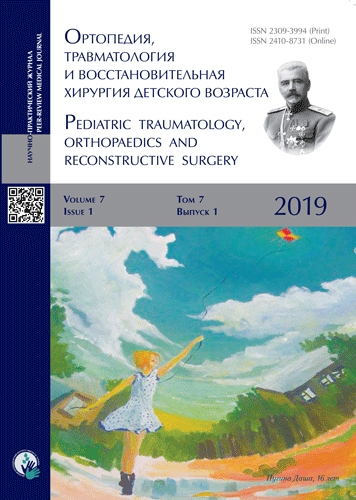Деструкция голеностопного сустава (атипичный сустав Шарко) вследствие одностороннего остеолиза у девочки с наследственной нечувствительностью к боли без ангидроза (наследственная сенсорная автономная нейропатия V типа): клинический случай и обзор литературы
- Авторы: Аль-Каисси А.1,2, Грилль Ф.2, Гангер Р.2
-
Учреждения:
- Институт Остеологии имени Людвига Больцмана, Больница скорой помощи Майдлинг, Первая медицинская клиника больницы Ханнуш
- Ортопедическая клиника Шпайзинг, педиатрическое отделение
- Выпуск: Том 7, № 1 (2019)
- Страницы: 81-86
- Раздел: Клинические случаи
- URL: https://bakhtiniada.ru/turner/article/view/11635
- DOI: https://doi.org/10.17816/PTORS7181-86
- ID: 11635
Цитировать
Аннотация
Актуальность. Наличие у ребенка артропатий Шарко, вывихов суставов, остеомиелита и переломов при отсутствии явных признаков неврологической патологии должно вызывать подозрение на наследственную нечувствительность к боли (наследственная сенсорная и автономная нейропатия). Наследственная сенсорная и автономная нейропатия (НСАН) представляет собой редкий синдром, характеризующийся наследственной нечувствительностью к боли, изменением температуры кожи и нарушениями образования вегетативных нервных волокон. НСАН подразделяют на пять типов: сенсорную корешковую нейропатию (НСАН I), наследственную сенсорную нейропатию (НСАН II), семейную дизавтономию, или синдром Райли – Дея (НСАН III), наследственную нечувствительность к боли с ангидрозом (НСАН IV) и наследственную нечувствительность к боли без ангидроза (НСАН V).
Описание клинического случая. Девочка 13 лет, родилась от первой беременности у генетически неродственной семейной пары, поступила с неправильным сращением после нескольких последовательных переломов в области голеностопного сустава на фоне значительных литических изменений и остеонекроза (сустав Шарко). Пациентка перенесла множество безболезненных травм, что привело к переломам с последующей деформацией ее голеностопного сустава. У нее отмечались артропатии коленных и голеностопных суставов, суставов предплюсны и стопы без болей, которые должны были быть вызваны очевидными изменениями формы голеностопного сустава. Несмотря на нормальную тактильную чувствительность, у пациентки из-за нечувствительности к боли наблюдались повреждения кожи над костными выступами лодыжки.
Заключение. В большинстве случаев ортопедическое лечение таких пациентов чрезвычайно затруднено, так как у них имеются проблемы с полноценной иммобилизацией вследствие отсутствия защитного болевого рефлекса. Тем не менее наши попытки стабилизировать голеностопные суставы хирургическим путем оказались успешными, и в итоге девушка смогла ходить. Наиболее важным компонентом плана лечения этих детей является обучение пациентов и родителей умению защищать суставы и предотвращать травмы. Остеолиз голеностопного сустава у данного ребенка может быть отнесен к вторичному типу остеолиза.
Полный текст
Открыть статью на сайте журналаОб авторах
Али Аль-Каисси
Институт Остеологии имени Людвига Больцмана, Больница скорой помощи Майдлинг, Первая медицинская клиника больницы Ханнуш; Ортопедическая клиника Шпайзинг, педиатрическое отделение
Автор, ответственный за переписку.
Email: ali.alkaissi@oss.at
ORCID iD: 0000-0003-1599-6050
профессор
Австрия, ВенаФранц Грилль
Ортопедическая клиника Шпайзинг, педиатрическое отделение
Email: Grill.franz@gmx.net
профессор
Австрия, ВенаРудольф Гангер
Ортопедическая клиника Шпайзинг, педиатрическое отделение
Email: rudolf.ganger@oss.at
профессор
Австрия, ВенаСписок литературы
- Samueles M, Feske S. Inherited neuropathy. In: Office practice of neurology. New York: Churchill Livingstone; 1996. P. 540-548.
- Swaiman KP. Peripheral neuropathies in children. In: Pediatric neurology, principles and practice. St. Louis: Mosby; 1989. P. 1105-1123.
- Swanson AG. Congenital insensitivity to pain with Anhydrosis. Arch Neurol. 1963;8(3):299. https://doi.org/10.1001/archneur.1963.00460030083008.
- Swanson AG. Anatomic changes in congenital insensitivity to pain. Arch Neurol. 1965;12(1):12. https://doi.org/10.1001/archneur.1965.00460250016002.
- Edward M, Breet E. Neuromuscular disorders: peripheral neuropathy. In: Pediatric neurology. 2nd ed. New York: Churchill Livingstone; 1991. P. 117-139.
- Krettek C, Gluer S, Thermann H, et al. Non-union of the ulna in a ten-month-old child who had type IV hereditary sensory neuropathy. J Bone Joint Surg. 1997;79(8):1232-1234.
- Mazar A, Herold HZ, Vardy PA. Congenital sensory neuropathy with anhidrosis. Orthopedic complications and management. Clin Orthop. 1976;(118):184-187.
- Kenis V, Baindurashvili A, Ivanov S. Charcot arthropathy in children. Wound Medicine. 2013;2-3:16-21. https://doi.org/10.1016/j.wndm.2013.10.005.
- Hicks JH. Rigid fixation as a treatment for hypertrophic non-union. Injury. 1977;8(3):199-205. https://doi.org/10.1016/0020-1383(77)90132-2.
- Jolly GP, Zgonis T, Polyzois V. External fixation in the management of Charcot neuroarthropathy. Clin Podiatr Med Surg. 2003;20(4):741-756. https://doi.org/10.1016/s0891-8422(03)00071-5.
- Zgonis T, Stapleton JJ, Jeffries LC, et al. Surgical treatment of charcot neuroarthropathy. AORN J. 2008;87(5):971-990. https://doi.org/10.1016/j.aorn. 2008.03.002.
- Gorham LW, Stout AP. Massive osteolysis (acute spontaneous absorption of bone, phantom bone, disappearing bone); its relation to hemangiomatosis. J Bone Joint Surg Am. 1955;37-A(5):985-1004.
Дополнительные файлы










